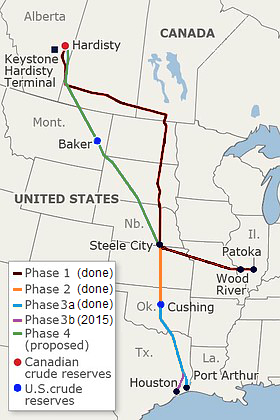Keystone XL Final Supplemental Environmental Impact Statement: GHG Analysis & Next Steps
The Final Supplemental Environmental Impact Statement & Next Steps
On January 31, the United States State Department issued its Final Supplemental Environmental Impact Statement (EIS) on the Keystone XL pipeline, which is designed to transport oil sands bitumen from Hardisty, Alberta to Steele City, Nebraska. The environmental impact statement was issued to comply with the National Environmental Policy Act, 42 U.S.C. 4321 et seq., which requires agencies to consider the environmental impact of major federal actions.
As noted in a previous post on Ablawg, President Obama raised the stakes for this environmental impact statement in June when he stated that he would only approve the pipeline if it would “not significantly exacerbate the problem of carbon pollution.” As described below, the final EIS suggests that Keystone XL meets this standard, but does not entirely rule out a contrary decision.
Now President Obama must decide whether the pipeline is in the “national interest” under Executive Order 13337, which governs cross-border pipelines. But first there will be 105 days of comment periods for federal agencies and the public. A further wildcard is that the State Department’s Inspector General is imminently expected to issue a report on whether the independent contractors that performed the environmental impact assessment on Keystone XL had a conflict of interest.
The President’s decision on the pipeline is delegated to Secretary of State John Kerry. If other US federal agencies object to his decision, then the President will have to decide himself whether to overrule Secretary Kerry’s decision. If the pipeline is approved, environmental groups will challenge this decision in U.S. court.
State Department’s Analysis of the Greenhouse Gas Impact of Keystone XL
The State Department concludes that Keystone XL, like “any one crude transport project . . . is unlikely to significantly impact the rate of extraction in the oil sands” and thus unlikely to increase greenhouse gas emissions. State Department, Final Supplemental Environmental Impact Statement at ES-16. And it goes further, stating that even if “new east-west and cross-border pipelines were both completely constrained, oil sands crude could reach U.S. and Canadian refineries by rail.” State Department, Final Supplemental Environmental Impact Statement at ES-12. As a result, the State Department estimates that rejecting the pipeline would actually lead to higher greenhouse gas emissions than approving it, due to the higher energy requirements of shipping crude by rail—“28 to 42 percent” higher. State Department, Final Supplemental Environmental Impact Statement at ES-34 &Table ES-6.
The State Department’s estimate that rejecting the pipeline would mean 28 to 42 percent higher emissions due to rail is a significant increase from its earlier assessment that rejecting the pipeline would increase emissions by “about eight percent.” State Department, Draft Supplemental Environmental Impact Statement 5.1-26. That being said, the State Department’s conclusion that the pipeline is “unlikely to significantly impact” oil sands extraction is a slight retreat from its Draft report, which concluded there would be “no substantive change in global GHG emissions.” State Department, Draft Supplemental Environmental Impact Statement 4.15-107. And the State Department also acknowledged that, if global oil prices fell significantly (West Texas Intermediate under $75 a barrel), then rejecting the pipeline could decrease greenhouse gas emissions because “higher transportation costs could have a substantial impact on oil sands production levels.” State Department, Final Supplemental Environmental Impact Statement at ES-34 &Table ES-12.
Moving forward, a crucial question will be if other U.S. federal agencies support the State Department’s analysis. When the State Department released its draft environmental impact statement, the U.S. Environmental Protection Agency critiqued its treatment of crude-by-rail. It requested “a more careful review of . . . rail transport options,” because it thought that, if the pipeline was not approved, high crude-by-rail costs might slow oil sands production and thus, greenhouse gas emissions. U.S. EPA Keystone XL Project Comment Letter (Apr. 22, 2013). In response, the State Department expanded its climate change, oil market, and rail transport analysis. State Department, Final Supplemental Environmental Impact Statement at ES-34 &Table ES-1. It remains to be seen whether agencies like the Environmental Protection Agency will be satisfied with the expanded analysis or remain skeptical of the State Department’s mostly unaltered conclusions.

 On April 25, Michael Bishop, a farmer acting pro se, filed a
On April 25, Michael Bishop, a farmer acting pro se, filed a